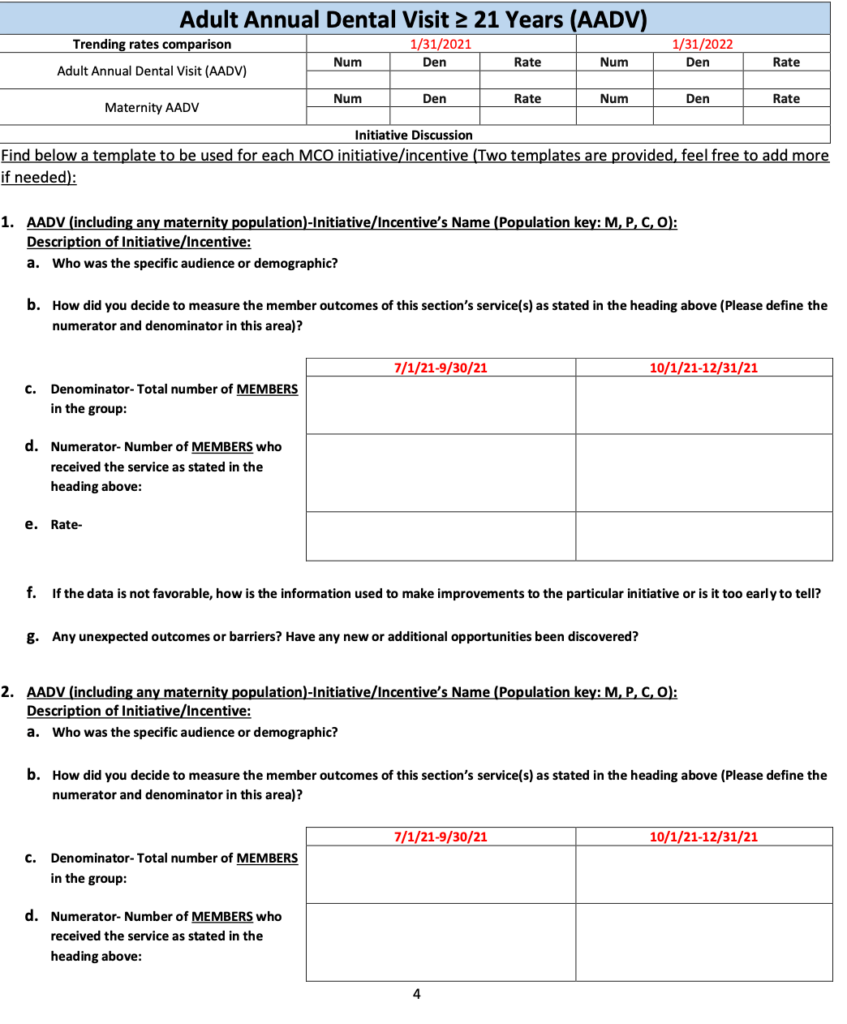Inequities in oral health and health outcomes are driven by upstream factors, including diet, education, transportation, and access to care. A growing number of states are working to improve the oral and physical health of Medicaid enrollees and reduce costs by addressing these social determinants of health in their managed care contracts.
Recently, states have used Medicaid managed care contracts and value-based purchasing agreements to address the education, food, and transportation needs of their enrollees. However, less is known about how states leverage their purchasing clout to improve dental care or address social determinants of health (SDOH) directly in dental contracts.
To learn how state Medicaid programs include social determinants of health in their dental and medical Medicaid managed care contracts, view this interactive map.
A 50-state review by the National Academy for State Health Policy (NASHP) of Medicaid dental and medical managed care contracts, requests for proposals, and other similar documents publicly available through September 2020, identified how states address social determinants of oral health. Dental contracts were reviewed for a comprehensive list of social determinants and medical contracts were analyzed for references to care coordination, community resources, food access, social determinants of health screening, and coordination with dental contractors. In total, NASHP scanned dental contracts in 19 states and medical contracts in 38 states.
Of the dental contracts, nine referenced coordination between dental plans and medical plans and 13 referenced coordination with social and community services. Other common references in dental contracts included equity/cultural competence, education, and transportation (each referenced in 10 state contracts).
All but one of the 38 medical contracts referenced coordination with social and community services. Thirty-three states referenced food in their medical contracts, 25 referenced adverse experiences (such as domestic violence and child abuse), and 15 referenced care coordination between dental and medical care. Three states (Florida, Michigan, and Virginia) referred to food in both their dental and medical contracts, while only one (Virginia) referenced adverse experiences in both contracts.
State Medicaid Program Delivery of Dental Care
While Medicaid covers some form of adult dental care in 47 states and Washington, DC, and all states cover dental care for children under 21 as part of the Early Periodic Screening, Diagnosis and Treatment (EPSDT) program, adult dental coverage is optional for state Medicaid programs. Currently, 35 states provide limited dental benefits for adults and 19 states offer extensive adult dental benefits.
States have different options for delivering dental care. Some states with managed care use a carve-in model, where the dental benefit is integrated into medical managed care programs. With a carved-in benefit, managed care organizations (MCOs) may administer the dental benefit or subcontract the dental benefit to another vendor. In carve-out dental programs, states contract with a dental MCO or dental benefits manager (DBM). Alternatively, states with Medicaid managed care medical delivery systems may have fee-for-service dental systems.
Medicaid dental and medical contracts illustrate how states can consider social determinants affecting oral health and overall health through:
- Screening, referral tracking, and follow-up;
- Educational initiatives;
- Staffing and training requirements;
- Data sharing and technology;
- Coordination between dental and medical systems; and
- Performance improvement.
Social Determinants of Health in Dental and Medical Medicaid Contracts
Almost all states scanned have some requirement for plans to refer members to community resources and social services. NASHP focused specifically on requirements that are applicable to the general population, rather than individuals designated as high risk or high needs. States use a variety of strategies to encourage investment in SDOH.
Screening for SDOH Needs
Sixteen states use routine screenings for certain social determinants, including employment status and access to food and transportation. The scan of 14 medical contracts and two dental contracts indicate that states are more likely to require medical plans to conduct needs assessments, often within a specified time frame after enrollment, than dental plans. States may also require medical plans to use this data to appropriately target interventions to meet enrollees’ needs.
While dental plans do not necessarily have the same explicit requirement to conduct a screening, some states do ask their dental plans to use SDOH data to target their educational and outreach activities.
- Michigan’s dental plan is required to use social determinants of oral health data from the state in order to target interventions, outreach, and education efforts.
- Nevada’s dental contract requires the contractor to complete a community-based needs assessment to inform their health promotion and educational activities, including ensuring that any interventions are culturally appropriate and meet the needs of the target population.
Referral Tracking and Follow-up
While screening is an important first step in identifying members’ social needs, it also raises a question of how states use the data to address social determinants. NASHP found that in almost every state with publicly available contracts, Medicaid agencies partner with community-based organizations to meet the social needs of enrollees. For example, plans may facilitate referrals to these community agencies based on information collected through SDOH screenings. States can use tracking, follow-up, and reporting requirements to ensure that referrals to community resources and organizations are effective and successful. Contractors can support these efforts by documenting “closed-looped” referrals that ensure that an enrollee is successfully connected with a community-based organization to address other health and social needs.
- In Louisiana, the Dental Benefit Program Manager is required to connect enrollees with community-based service providers and document referrals and referral outcomes in enrollees’ dental records.
Dental contracts are less likely to require or encourage the plan to monitor referral follow-up. However, dental plans could adopt some of the medical MCOs’ language in order to track the status of referrals, strengthen care coordination between insurance plans and community resources, and ensure individuals are receiving adequate social services that meet their evolving needs. For example, New Hampshire requires MCOs to track the effectiveness of community-based providers and resources, and Oregon requires reporting on referrals to culturally diverse social and support services.
Educational Initiatives
Healthy People 2020 identified health literacy as a component of SDOH, noting that individuals’ ability to access and understand relevant health information affects their health and health outcomes. To help improve health literacy, many states require managed care plans to implement educational initiatives. For dental plans, this includes educating members about the importance of oral health or launching community oral health initiatives designed to help eliminate barriers to dental services and improve population oral health.
- In both Nevada and Texas, the dental contractor must develop and implement programs designed to educate members about nutrition, the importance of oral health, and the relationship between oral health and overall health.
- Florida’s dental plan includes incentives for participation in health education classes. Examples of incentives members can receive that support healthy child development include clothes, food, books, safety devices, publications, and memberships in health and education clubs.
- In its response to Nebraska’s request for proposals (RFP), dental contractor MCNA referenced a program it implemented in Texas that uses the fotonovela (a comic book-style communication popular in the Latinx community) to distribute health information materials to children of migrant farm workers.
Staffing and Training Requirements
Plans may also be responsible for training their employees to better meet members’ needs. In their contracts, states can prioritize the type of training that a plan’s staff receive.
- Nebraska’s dental contract requires all staff to be trained on how social determinants (including food, housing, education, violence, and physical and sexual abuse) affect members’ health and wellness. Staff also receive training on how to find community resources and make referrals.
Both medical and dental plans also employ staff members who are responsible for care coordination, addressing social determinants, and improving access to care for historically marginalized populations.
- Nebraska’s dental contract requires the plan to employ a tribal network liaison to coordinate and expand dental services to Native Americans and connect them to community resources. Arizonaand New Mexico both require medical MCOs to employ someone to coordinate services with Native Americans.
Examples of other medical plans’ required staff positions include a community liaison in Illinois, who connects enrollees with community-based services, and a service coordination director in Kansas, who oversees quality improvement initiatives related to SDOH. Dental contractors could potentially leverage medical MCO positions and their expertise to streamline care experiences for enrollees across medical and dental systems.
Coordination between Dental and Medical Systems
To better integrate dental and medical care, dental and medical managed care use staff members to connect physical health and oral health services across contracts. These staff members also connect Medicaid enrollees to community services to meet social needs.
- In its dental contract, Tennessee requires a coordinator to work with the medical MCO and develop a system to exchange data with the MCO.
- Florida requires MCOs to have a liaison for their prepaid dental health plan to help integrate medical care, behavioral health, and long-term benefits with the dental plan.
- Iowa requires the dental contractor to send a care facilitation plan to the state with information on how the plan will facilitate coordination between dental and medical plans and providers.
Data Sharing and Technology
Eleven states require some form of data sharing between dental and medical plans, or between plans and community organizations. Requirements for integrating different agencies’ social determinant data and sharing information across systems allow medical, dental, and social services to work together to coordinate care for members and encourage referrals and follow-up tracking.
- In Tennessee, the dental benefits manager must facilitate data exchange with school-based health programs to coordinate any needed follow-up care.
- Washington State tasks its dental contractors with using health information technology and health information exchanges to coordinate care between physical health, behavioral health, and social services and other community-based organizations.
Other states are creating their own online platform or mobile applications to improve access to social services for their Medicaid enrollees. These platforms are mentioned specifically in medical managed care plan contracts, but have the potential to be used by dental contractors as well.
- Kansas developed a web-based, mobile-friendly application that connects service coordinators to community resources, such as food banks and pantries, housing, clothing, legal resources, and transportation.
- Medicaid Prepaid Health Plans in North Carolina will use a telephonic, online, and interfaced IT platform to refer members to social services and track the outcomes of these referrals.
Performance Improvement
A number of states encourage both dental and medical plans to engage in performance improvement projects (PIPs) in order to address SDOH.
- In Nevada, dental vendors are required to conduct both a clinical and non-clinical PIP every year. Non-clinical PIPs can focus on cultural competency and accessibility of services, among other SDOH.
- Oregon Coordinated Care Organizations (CCOs) must implement PIPs that address at least four of eight designated focus areas, which include addressing SDOH and equity, and integrating primary care, behavioral health care, and/or oral health care.
Through these PIPs, state managed care plans (both dental and medical) can launch pilot interventions to improve health outcomes by addressing SDOH and reducing barriers to care.
Conclusion
Research shows that addressing individual social needs leads to better oral health outcomes. Despite having different levels of funding and varying Medicaid adult dental benefits, states across the country are finding ways to invest in SDOH. While not all states have started to include SDOH requirements in their dental contracts, these examples show potential opportunities for dental plans to integrate some of the medical plans’ language and guidance into their own work. To learn more about how state Medicaid programs include SDOH-related language in their dental and medical Medicaid managed care contracts, view this interactive map.
Acknowledgements: This blog and map were made possible by the DentaQuest Partnership LLC. The authors would like to especially thank Trenae Simpson for her guidance and assistance, and Trish Riley and Jill Rosenthal for their helpful feedback. This information, content, and conclusions are those of the authors’ and should not be construed as the official position or policy of the DentaQuest Partnership LLC.



